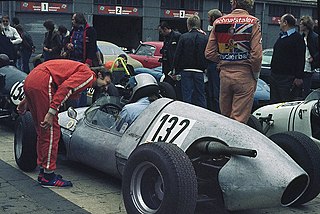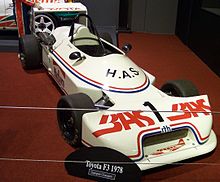
Formula Two is a type of open-wheel formula racing category first codified in 1948. It was replaced in 1985 by Formula 3000, but revived by the FIA from 2009–2012 in the form of the FIA Formula Two Championship. The name returned again in 2017 when the former GP2 Series became known as the FIA Formula 2 Championship.

Formula Three, also called Formula 3, abbreviated as F3, is a third-tier class of open-wheel formula racing. The various championships held in Europe, Australia, South America and Asia form an important step for many prospective Formula One drivers.

Formula Vee or Formula Volkswagen is a popular open wheel, single-seater junior motor racing formula, with relatively low costs in comparison to Formula Ford.

Formula Junior is an open-wheel formula racing class first adopted in October 1958 by the CSI. The class was intended to provide an entry level class where drivers could use inexpensive mechanical components from ordinary automobiles. The idea to form the new class came from Count Giovanni "Johnny" Lurani, who saw the need of a class for single-seater racing cars where younger drivers could take their first steps. It is often speculated that this class was founded as a reaction to Italy's lack of success in the 500 cc Formula Three, and although Italian marques dominated the first year of the formula, they were soon overtaken by British constructors.

Formula racing is any of several forms of open-wheeled single-seater motorsport. The origin of the term lies in the nomenclature that was adopted by the FIA for all of its post-World War II single-seater regulations, or formulae. The best known of these formulae are Formula One, Formula E, Formula Two, Formula Three, regional Formula Three and Formula Four. Common usage of "formula racing" encompasses other single-seater series, including the IndyCar Series and the Super Formula Championship.
The Atlantic Championship Series is an American open-wheel racing series with races throughout North America. It has previously been called Champ Car Atlantics, Toyota Atlantics, or just Atlantics.

Formula Atlantic is a specification of open-wheel racing car developed in the 1970s. It was used in professional racing through the IMSA Atlantic Championship until 2009 and is currently primarily used in amateur racing through Sports Car Club of America Formula Atlantic.

Ronald Sidney Tauranac was a British-Australian engineer and racing car designer, who with Formula One driver Jack Brabham founded the Brabham constructor and racing team in 1962. Following Brabham's retirement as a driver at the end of the 1970 season, Tauranac owned and managed the Brabham team until 1972, when he sold it to Bernie Ecclestone. He remained in England to assist with a redesign of a Politoys Formula One chassis for Frank Williams in 1973 and helped Trojan develop a Formula One version of their Formula 5000 car.
The Formula 3 Euro Series was a European-based junior single seater formula for Formula Three chassis that was launched in 2003 as a merger of the French Formula Three Championship and German Formula Three Championship. The Formula Three category, including this championship, is part of the established career ladder up which European drivers progress to the Formula One world championship, the highest form of single seater racing defined by the Fédération Internationale de l'Automobile (FIA), motorsport's world governing body.

Ralt was a manufacturer of single-seater racing cars, founded by ex-Jack Brabham associate Ron Tauranac after he sold out his interest in Brabham to Bernie Ecclestone. Ron and his brother had built some specials in Australia in the 1950s under the Ralt name. Tauranac won the 1954 NSW Hillclimb Championship in the Ralt 500.

Formula Super Vee was an open-wheel racing series that took place in Europe and the United States from 1970 to 1990. The formula was created as an extension of Formula Vee, a racing class that was introduced in 1959. Formula Super Vee in Europe was similar to F3 or Formula Renault today, a stepping stone to F1. In the United States, Formula Super Vee, often referred to as Super Vee, was a natural progression to Indy Car and Can-Am. On both sides of the Atlantic the series also was a platform for the promotion of VW products, similar to how Formula Renault promotes Renault products today.
The German Formula Three Championship was the national Formula Three championship of Germany, and the former West Germany, from 1950 to 2002, then as Formel 3 until 2014. In 2003, the series had merged with the French Formula Three Championship to form the Formula 3 Euro Series. The lower-level series, the ATS Formel 3 Cup, subsequently operated in Germany, but it folded after the end of the 2014 season. Since the late 1980s, the list of German F3 champions has included many notable drivers, including Formula One World Champion Michael Schumacher and nine-time Le Mans winner Tom Kristensen.

The Ralt RT3 is an open-wheel Formula 3 race car, developed and built by Ralt in 1979.

The Ralt RT4 is an open-wheel formula racing car, designed, developed, and built by Ralt for Formula Atlantic in 1980. It was later converted into a closed-wheel prototype and used in the revived Can-Am series between 1982 and 1985, where it achieved only modest success. In Can-Am competition, the car achieved 1 podium finish, 1 class victory, and a best result of a 2nd-place finish.
Royale Race Cars was a British constructor of race cars in the 20th century. The company produced single seaters as well as sports cars.
The SCCA Formula Super Vee was one of the longest running Formula Super Vee championships in the world. Twenty racing season were contested. Most of the races were sanctioned by the Sports Car Club of America in some occasions the races were sanctioned by the International Motor Sports Association.
Ken Duclos is a Americas former racing driver. Duclos competed in the Trans-Am Series, Atlantic Championship among other series.
The Ralt RT33 was a Formula 3 racing car that was developed and built by Ralt in 1989 and was used in various Formula 3 championships. A total of 37 chassis' were made.
The Swift DB4 is an open-wheel formula racing car chassis, designed, developed and built by American Company Swift Engineering, for the Formula Atlantic spec-series, between 1987 and 1997. It won the championship five times, with four championships won four consecutive years in a row. It was powered by naturally aspirated 1.6 L (98 cu in) Toyota 4A-GE four-cylinder engine, producing about 240 hp (180 kW), which drove the rear wheels through a standard 5-speed manual transmission.

The Mallock U2 is a race car, designed, developed and built by Major Arthur Mallock and later his son Richard. Arthur’s first customer race cars were simply called U2. The first of which the Mk1 were sold as kits in 1958. By about 1969 the name changed to Mallock U2. It was designed to compete in both single seater racing,eg Formula Junior and with the addition of cycle type mudguards in Sportscar racing. By 1965 a UK series was established to cater for “Lotus 7 type cars” or Clubmans which included the Mallock U2. purpose-built It was a versatile and highly effective front engined race car. It also competed in Formula Junior, Formula Ford, and Formula Three events. The chassis was constructed out of a steel tubular spaceframe, and it was later equipped with a De Dion rear axle, in 1972. It was very light, weighing only 948 lb (430 kg). It was powered by a number of different four-cylinder engines; including an 1,172 cc (71.5 cu in) Ford Sidevalve engine, a smaller 997 cc (60.8 cu in) Ford Kent engine, an 1,100 cc (67 cu in) BMC A-series engine, and even a 1.5–1.6 L (92–98 cu in) Ford-Cosworth SCA/Cosworth FVA engine. This drove the rear wheels through a conventional 4-speed manual transmission; first used in the Austin A30.












